If you’;je suis nouveau dans la broderie, apprendre les termes de la broderie machine est essentiel pour réussir. Ces termes clés vous aideront à utiliser correctement votre machine et vos matériaux.
Dans ce guide, nous décomposerons les termes les plus importants dans un langage simple, ce qui vous permet de créer plus facilement de beaux designs en toute confiance.
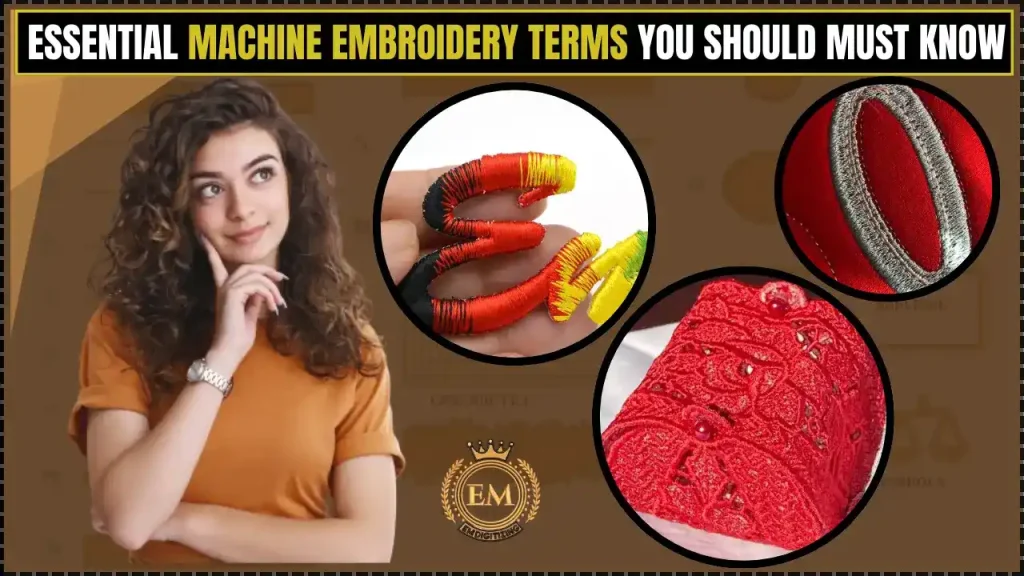
Termes essentiels de la broderie machine que vous devez connaître
Comprendre votre machine à broder
Pour utiliser votre Machine à broder correctement, il est important de connaître les principales parties et comment elles fonctionnent ensemble. Cela rendra vos projets de broderie beaucoup plus faciles et plus réussis..
Composants clés d'une machine à broder
Votre machine à broder comporte plusieurs pièces essentielles qui lui permettent de créer des motifs sur tissu. Comprendre ces termes de broderie machine vous aidera à utiliser la machine efficacement et à obtenir de meilleurs résultats..
Voici quelques-uns des composants les plus importants:
Cerceau de broderie: Un cadre qui maintient le tissu serré pendant la couture, assurant une broderie lisse et uniforme.
Aiguille: L'outil pointu qui se déplace de haut en bas pour créer des points à travers le tissu.

Bobine: Une petite bobine fournissant le fil inférieur, travailler avec le fil supérieur pour former des points.
Stabilisateur: Un matériau placé sous le tissu pour éviter tout étirement ou froncement pendant la broderie.
Cadran de tension du fil: Contrôle le serrage du fil pour garantir une couture uniforme et lisse..

Pied-de-biche: Maintient le tissu pendant qu'il se déplace dans la machine, permettant une couture précise.
Nourrir les chiens: Dents métalliques qui font avancer le tissu pendant la couture.
Plaque à gorge: Une plaque métallique avec une ouverture pour le passage de l'aiguille pendant la couture.
Barre à aiguille: Maintient l'aiguille et la déplace de haut en bas pendant le processus de broderie.
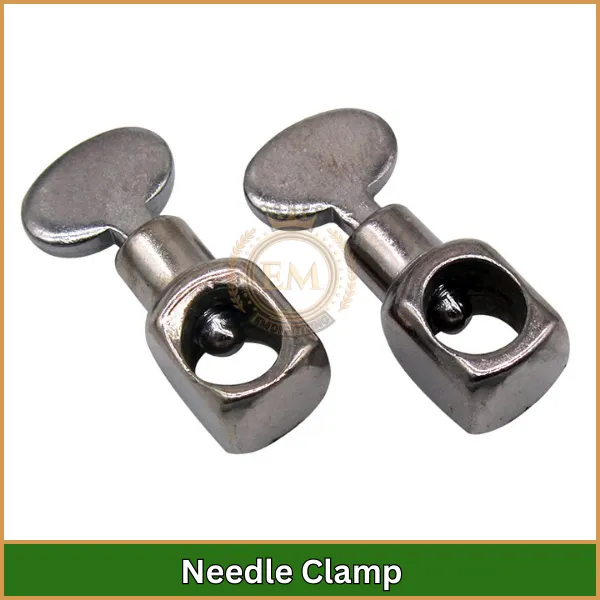
Pince à aiguille: Maintient l'aiguille en place, assurer la stabilité pendant la couture.
Porte-bobine: Tient la bobine de fil, lui permettant de se dérouler en douceur pendant que la machine coud.
Panneau de contrôle: L'interface où vous ajustez les paramètres et sélectionnez les motifs à broder.

Support de cadre de broderie (Bras): Déplace le cerceau pour suivre les coordonnées du motif pour un placement précis du motif.
Coupe-fil automatique: Coupe le fil automatiquement après une couture ou un changement de couleur.
Trimmer: Coupe l'excédent de fil entre les sections du motif pour garder le dos propre..
Mécanisme de changement de couleur: Bascule automatiquement entre couleurs de fil sur machines multi-aiguilles.
Comment fonctionne une machine à broder
Les machines à broder utilisent un système informatisé pour coudre des motifs sur du tissu. Vous chargez un fichier de conception dans la machine, mettre le tissu dans le cerceau, and the machine follows the design’;s instructions pour créer le motif avec du fil.
Conditions essentielles des matériaux de broderie machine
Comprendre le droit outils de broderie et les matériaux sont cruciaux pour des termes de broderie machine réussis. Ces outils et matériaux contribuent à garantir que vos conceptions soient fluides., précis, et d'aspect professionnel.
- Tissu: Le matériau de base sur lequel le motif de broderie est cousu. Différents tissus, comme le coton, lin, ou polyester, réagir différemment à la broderie, il est donc crucial de sélectionner le bon tissu pour obtenir les meilleurs résultats.
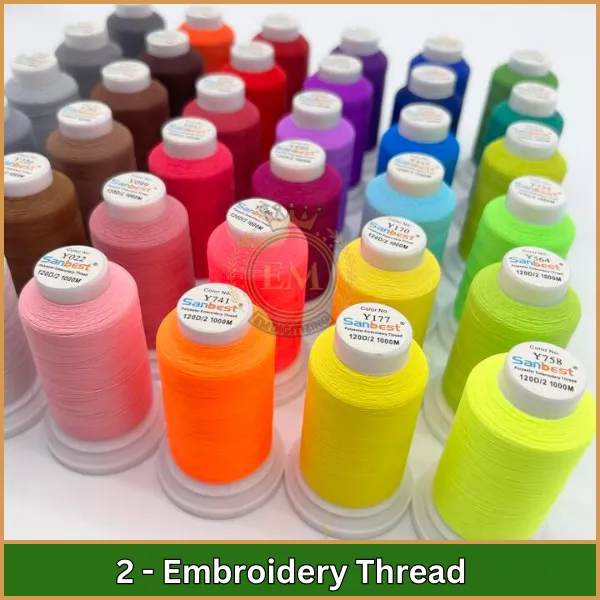
2. Fil à broder: Un type spécial de fil utilisé dans broderie à la machine termes.
Il est généralement fabriqué à partir de rayonne, polyester, ou en coton et est disponible dans une variété de couleurs pour ajouter du dynamisme à vos créations.
Les fils à broder sont conçus pour être solides et offrir une douceur, finition brillante.
- Stabilisateur: Un matériau de support placé sous ou derrière le tissu pour fournir un soutien supplémentaire pendant la broderie. Les stabilisateurs empêchent le tissu de s'étirer, déplacement, ou plissement, assurer que les points de conception soient fluides. Les types courants incluent les déchirures, en coupe, et stabilisants lavables.
- Cerceau: Un cadre qui maintient le tissu bien en place pendant le processus de broderie. Le cerceau est composé de deux anneaux: une bague intérieure et une bague extérieure, qui serre le tissu pour le maintenir stable, assurer des coutures précises.
- Aiguille: Un outil pointu utilisé pour coudre le motif dans le tissu. Les aiguilles à broder sont conçues pour manipuler les fils et tissus délicats sans causer de dommages.. Différentes tailles et types d'aiguilles sont disponibles en fonction du tissu et de la complexité du design..
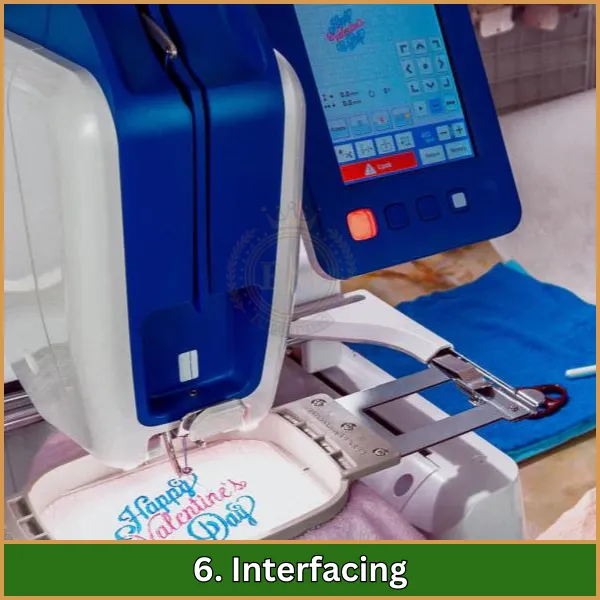
6. Interfaçage: Un matériau utilisé pour renforcer les tissus qui peuvent être trop fins ou délicats pour la broderie.
Il aide à stabiliser le tissu et à éviter toute déformation lors de la couture.
L'entoilage est souvent fusionné au tissu à l'aide de chaleur avant le début de la broderie..
- Stabilisateur soluble dans l'eau: Un type spécial de stabilisant qui se dissout lorsqu'il est trempé dans l'eau. Il est souvent utilisé pour la dentelle autoportante ou les tissus délicats où l'entoilage doit disparaître une fois la broderie terminée..
- Spray adhésif temporaire: Un spray utilisé pour maintenir temporairement le tissu, stabilisateur, ou appliqué en place avant de coudre. Il aide à empêcher le tissu de bouger pendant le processus de broderie et est particulièrement utile pour les tissus délicats..
- Tissu appliqué: Un morceau de tissu placé sur le tissu de base et cousu à l'aide de points de broderie. L'appliqué est une technique dans laquelle des formes sont découpées et cousues sur une pièce plus grande pour créer des motifs., ajoutant souvent de la texture et de la couleur à projets de broderie.
Bases de la numérisation pour la broderie
Dans le monde de termes de broderie machine, la numérisation est un processus essentiel où les dessins sont convertis dans un format que les machines à broder peuvent lire. Voici les termes clés utilisés en numérisation, avec leurs définitions.
Logiciel de numérisation
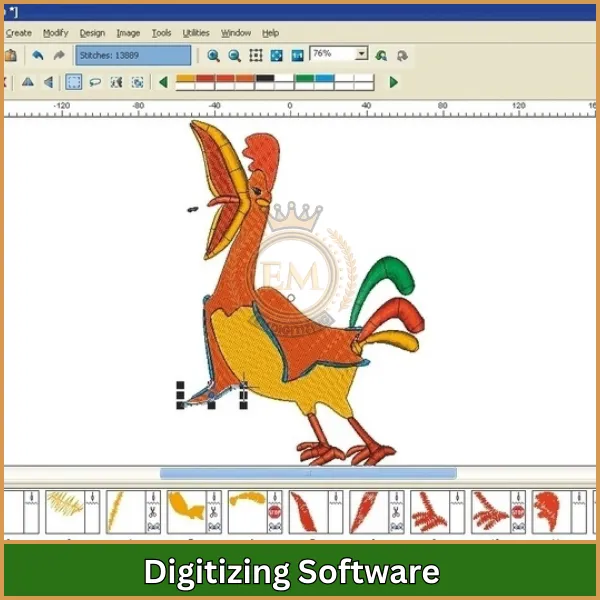
Il s'agit du logiciel informatique utilisé pour créer ou convertir un dessin en un fichier de broderie. Il permet à l'utilisateur de tracer les chemins de points, sélectionner les types de points, et ajustez les paramètres pour créer le motif final que la machine à broder suivra.
Numérisation automatique
Une fonctionnalité dans logiciel de numérisation qui convertit automatiquement une image ou un graphique en motif de point. Bien que ce soit une option plus rapide, il ne produit pas toujours une conception de la plus haute qualité car des ajustements manuels peuvent être nécessaires pour des détails complexes.
Numérisation manuelle
Il s'agit du processus par lequel l'utilisateur crée manuellement le conception de broderie point par point. Il offre un contrôle complet sur la conception, permettant une meilleure précision, surtout avec des motifs complexes ou détaillés.
Formats de fichiers de broderie
Ce sont les types de fichiers spécifiques qu'une machine à broder lit pour broder un motif.. Différentes machines utilisent différents formats. Les formats courants incluent:
- heure d'été (utilisé par de nombreuses marques, y compris les machines industrielles),
- PSE (utilisé par Brother et Babylock),
- JEF (utilisé par Janome),
- EXP (utilisé par Melco et Bernina).
Points de sous-couche
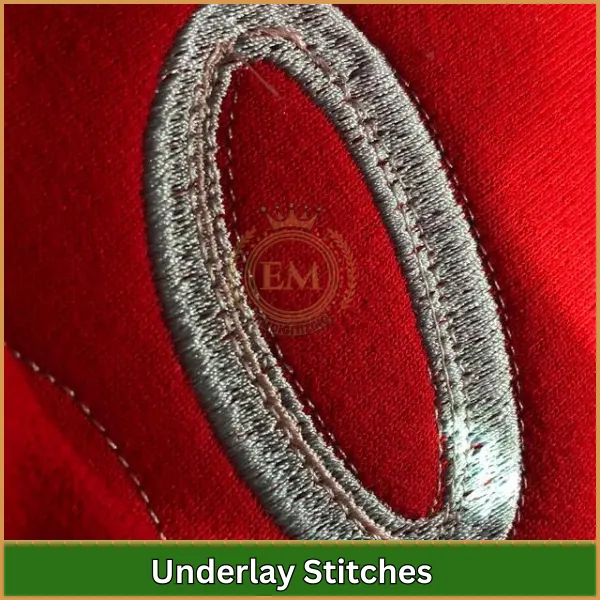
Ce sont les premiers points posés dans un design destiné à stabiliser le tissu et à le préparer pour la couture principale..
Les points de sous-couche sont généralement cachés dans le produit final, mais sont essentiels pour fournir de la structure et garantir que le motif conserve sa forme..
Compensation de poussée et de traction
Un paramètre dans un logiciel de numérisation qui compense le mouvement ou la distorsion du tissu pendant le processus de broderie. Il garantit que les points restent alignés avec le motif original malgré le déplacement ou la traction du tissu pendant la couture..
Trajectoire
Le cheminement fait référence à l'ordre dans lequel les points sont disposés pendant la broderie.. Un cheminement approprié minimise les sauts inutiles ou les coupures de fil, rendre la machine plus efficace et produire des résultats plus propres.
Densité
La densité fait référence à la proximité avec laquelle les points sont placés dans un motif. L'ajustement de la densité peut affecter l'apparence, texture, et la rigidité de la conception. Une densité trop élevée peut rendre le tissu rigide, alors que trop peu peut entraîner des espaces ou des coutures lâches.
Types de points: Du basique au complexe

Différents types de points créent différents effets dans vos motifs de broderie. Voici quelques-uns des points les plus courants:
- Point courant: Il s'agit d'un point simple qui forme une ligne droite et est souvent utilisé pour décrire des motifs ou ajouter de petits détails..
- Plumetis: Les points satin créent une douceur, zones de fil brillantes et idéales pour les bordures, des lettres, ou remplir de petites zones.
- Point de remplissage (Point de tatami): Un point de remplissage est utilisé pour couvrir de grandes zones d'un motif avec des points serrés.. Il ajoute de la texture et remplit les formes de couleur.
- Point zigzag: Un point qui se déplace d'avant en arrière en zigzag. Ce point est souvent utilisé pour les bordures décoratives ou pour la finition des bords du tissu..
- Point de croix: A stitch that forms an ‘;X’; forme sur le tissu. Il est souvent utilisé dans la broderie à la main, mais peut être adapté aux termes de broderie machine pour créer des motifs complexes..
Maîtriser les termes de la broderie machine: Techniques avancées
L'apprentissage de techniques avancées peut vous aider à faire passer vos projets de broderie au niveau supérieur.. Voici quelques techniques clés à maîtriser:
Points de superposition
La superposition de points consiste à empiler différents types de points les uns sur les autres pour créer de la profondeur et de la texture dans votre motif.. Cette technique ajoute un aspect plus professionnel et dimensionnel à votre broderie.
Fil dégradé
Cette technique utilise du fil qui change progressivement de couleur, créer un effet de fondu ou de mélange dans le design. Il est parfait pour ajouter une touche dynamique et artistique à votre broderie.
3D Broderie

3La broderie D utilise de la mousse ou d'autres matériaux placés sous les points pour faire ressortir le motif du tissu., créant un effet tridimensionnel en relief. Il est couramment utilisé pour les logos audacieux ou les objets décoratifs.
Dans le cerceau (ITH) Projets
Les projets ITH sont entièrement réalisés dans le cadre cercle à broder, ce qui signifie que vous pouvez créer des objets complets comme des sacs, jouets, ou des sous-verres sans retirer le tissu du cerceau. Cette technique combine couture et broderie en une seule fois.
Appliqué
L'appliqué est une technique dans laquelle des morceaux de tissu sont placés sur le tissu de base, puis cousus à l'aide de broderie.. Il permet différentes textures et couleurs, rendre les designs plus dynamiques et intéressants.
Dentelle autoportante (FLS)
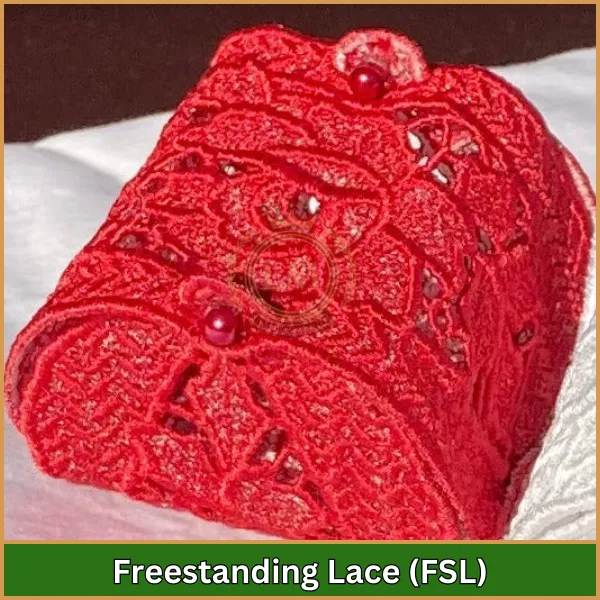
La dentelle autoportante consiste à créer des motifs de dentelle complexes qui peuvent être autonomes sans base en tissu..
Cela se fait en cousant sur un stabilisateur soluble dans l'eau., qui se dissout une fois la broderie terminée, ne laissant que la dentelle derrière.
Conclusion
Apprendre ces termes de broderie machine rendra l'utilisation de votre machine à broder plus facile et plus amusante.. Connaître ces termes vous aidera à éviter les erreurs et à créer de superbes designs rapidement et facilement..
À EMnumérisation, nous pouvons vous aider à transformer vos idées en motifs de broderie. Nous offrons un service rapide, prix bas, et un travail de haute qualité pour garantir que vos créations soient parfaites.
Plus, si c'est la première fois que vous travaillez avec nous, tu auras 50% de réduction sur votre première commande! Laissez-nous vous aider avec la partie la plus difficile afin que vous puissiez profiter de la réalisation de vos projets de broderie.
FAQ
Il existe principalement deux types de broderie machine: broderie en piqué libre et broderie informatisée. La piqué libre repose sur un contrôle manuel, tandis que la broderie informatisée utilise des motifs préprogrammés pour des coutures précises.
Les six points de broderie essentiels incluent le point courant, point arrière, plumetis, point de tige, noeud français, et marguerite paresseuse. Ces points constituent la base de la création de diverses textures et motifs en broderie..
Les meilleures machines à broder du monde 2024 inclure:
- Frère SE600
- Frère SE1900
- Bernette b79
- Artisanat de la mémoire de Janome 14000
- Artisanat de la mémoire de Janome 9850
Le nœud d'investissement est considéré comme l'un des points de broderie les plus difficiles. Son apparence complexe en forme de bobine exige de la précision, car cela nécessite d'enrouler le fil autour de l'aiguille plusieurs fois avant de le tirer à travers le tissu.
